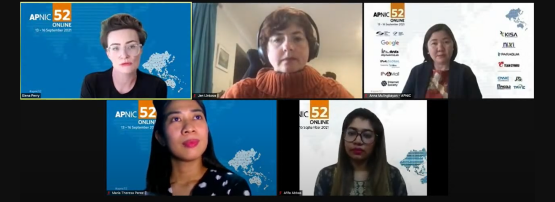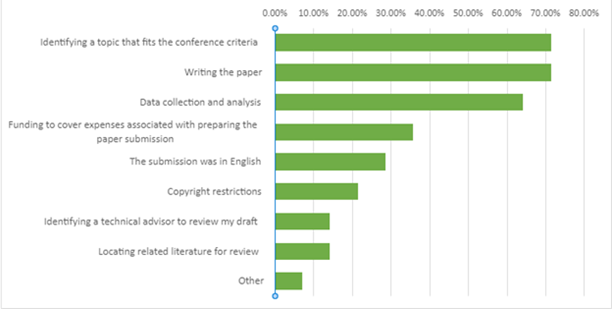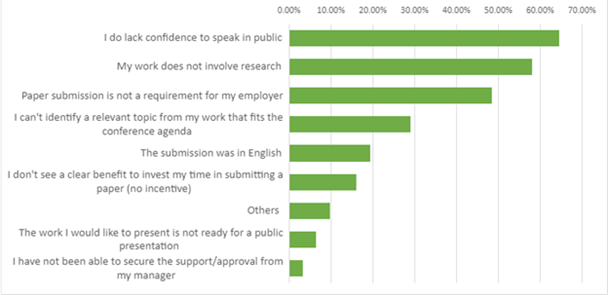
In September, at APNIC 52, the theme of the Women in ICT session was ‘Get Presenting Bootcamp!’
One of the goals of the session was to explore how we remove barriers for women to submit presentations at APNIC community events and meetings, by sharing practical advice and tools. The aim was to increase the number of paper submissions by female authors at these events.
Why? Because although the APNIC community is approximately 13% female, often there are few to no papers and presentations by women at our events.
Why is this an issue? Because our community is strengthened by a diversity of experiences and perspectives. The more voices we hear from, the richer our understanding of our work, challenges and opportunities.
As one of the panellists, I shared my experiences in overcoming challenges and in getting support in my work from my time as a researcher at the University of the Philippines, Diliman. Since the nature of my work involved research, I admittedly did not encounter a lot of external challenges. Paper submissions were a required deliverable of the funding organization that funded my research, and we also had mentors who were part of the PhD/Master faculty at the university. They encouraged and guided the exploration of a research topic as co-authors of the paper.
But I am just one person with one perspective; I decided, along with my team at SWITCH SEA, to conduct a mini survey.
This survey aimed to identify reasons why women do not submit papers, and for those who do successfully submit papers, identify the challenges they encounter and how they successfully overcome these.
I hope this shared knowledge will result in a better understanding of the barriers, thus creating appropriate and focused solutions to achieve our goal of more paper submissions.
Understanding the challenges in submitting papers
40 female respondents working in the Internet industry participated in the survey. They work in the academic sector, government, NGOs, and the private sector (such as Internet Service Providers and telecommunications companies).
35% of the respondents have submitted a paper before, and Figure 1 shows the challenges they encountered.

The top five challenges encountered are: (1) Finding a topic; (2) Writing the paper; (3) Data collection and analysis; (4) Funding; and (5) The submission was in English.
As with my experience, most of the challenges are internal factors and related to the conduct of the actual research. A key reason why I was able to overcome the same challenges was mentor support and encouragement, as they guided me throughout the research process.
Figure 2 shows the challenges faced by the approximately 65% of respondents who have not submitted a paper before.

The top five challenges are: (1) Respondents lack confidence; (2) The work does not involve research; (3) Submission is not a requirement from the employer; (4) Finding a topic; and (5) The submission was in English. It can be observed that the three top challenges identified are employer-related or external challenges to the participants. This result can help us think of ways to work with employers to encourage submissions of papers.
The confidence piece is interesting: There is lots of research that suggests that even when women are as competent professionally as their male counterparts, they are less confident in their abilities. This can become a self-confirming cycle; the more confident you are in your abilities, the more opportunities tend to be provided for you.
You can find confidence in doing something new, challenging or outside your comfort zone and learning from it. A perfect example of this is… you guessed it… submitting a paper to a conference!
Another common challenge, regardless of experience submitting papers, was finding a topic and submitting it in English. This result confirms that the language used in technical conferences is a barrier, and we can also investigate how we can address this as part of being a more inclusive community.
These results identified the top and specific challenges faced in submitting papers for conferences. Though we only had women participating in this survey, it is also interesting to know if men are also faced with the same barriers and if it is in the same order. Further research into this could be useful to better understand the barriers to submitting papers for a wider group of people.
Why do we need to present?
Identifying that one of the biggest barriers to paper submission is not having clarity of the benefits in presenting and submitting papers in conferences, we need to answer the question: Why do we need to present?
In my experience, presenting a paper is a way of representing the community I come from and making their voices heard through mine. It also allows me to be visible, and be a part of a community that shares the same goals.
Presenting a paper will also strengthen our collective ability to build and maintain the Internet by sharing operational research, experiences, failures, or successes as a community. Submitting papers and presenting in conferences can also give us a platform to hear from the broadest cross-section of our community.
How about you? What are the barriers you have encountered in submitting papers for conferences?
Maria (Mia) Theresa Perez is the SWITCH SEA National Coordinator for the Philippines.
SWITCH SEA is supported by the APNIC Foundation with funding from Australia’s Department of Foreign Affairs and Trade’s Cyber and Critical Technology Cooperation Program.
The views expressed by the authors of this blog are their own and do not necessarily reflect the views of APNIC. Please note a Code of Conduct applies to this blog.
